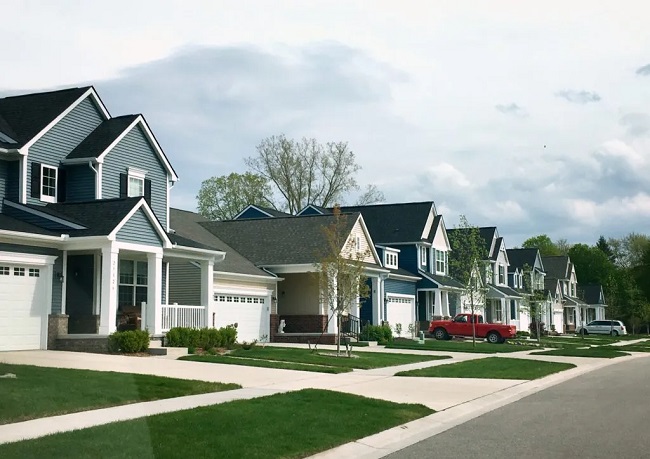Claudia Ruffle always wanted to be a part of a cohousing neighbourhood. She yearned to find others who cared as much about the planet as she did. However, she was an introvert and had a hard time striking up conversations with strangers.
Denmark’s cohousing movement gave the 72-year-old Ruffle, a former substitute teacher and administrative secretary, “a structure where I didn’t have to be outgoing and could yet have the benefit of getting to know others,” she said. “It made up for my shyness,” I said.

Construction on Rocky Corner, a 33-Acre Site
That’s why she was an early backer of the concept that would eventually become the first cohousing community in the state of Connecticut. Construction on Rocky Corner, a 33-acre site in the New Haven suburb of Bethany, began in 2018 after more than a decade of planning.
The year 2019 will mark the close for Ruffle and his companion, who have already sold their New Haven home in preparation for the acquisition of one of the adjacent flats there. Their deadline kept getting pushed again, though.
The community was subsequently informed that the project was experiencing a cash-flow issue. According to Ruffle, the couple initially planned to pay in full for their apartment upon moving in.
However, the entire development was foreclosed. And Ruffle’s hopes, along with his bank account, were crushed.
Read Also:
No Way to Get it Back
That cash is long gone, and there’s no way to get it back, she claimed. There was a loss of almost $170,000. Our financial situation is similar because none of us makes much money. After that, everything went downhill quickly, and we’ve been struggling ever since.
Different Rocky Corner locals have different theories as to what went wrong. But in general, most agree that the increasing complexity of the project proved more than the group could finance or manage.
Dick Margulis, a book designer and editor whose wife was one of the community’s original founders, remarked, “Mistakes were made all along the line by all sides.”
Karen Gimnig, interim executive director of the Cohousing Association of America, a national charity that supports newly developing and existing communities, emphasised that the events at Rocky Corner do not reflect the viability of cohousing in general.
According to the Cohousing Association, there are currently around 170 functioning cohousing communities in the United States.
Roughly thirty cohousing communities can be found in the Golden State, while around twenty can be found in the Evergreen State of Washington. Cohousing is a form of community-oriented housing in which individuals or families each have their own dwelling but share communal areas.
For Gimnig, “things could happen” on a construction site, just like on any other development site. However, “this is quite unusual.”
She said that the group always recommends that anyone building such communities work with seasoned cohousing developers to lessen their exposure to risk.
She noted that most cohousing developments rely on access to municipal water and sewer, but that the Rocky Corner development was located on a rural site that set aside some of its land for farming.
Unpaid Loans on the Project Totaling Around $6.7 Million
Ion Bank, a Naugatuck-based bank, recently acquired the site through a limited liability corporation, although only roughly half of the thirty dwellings had been built. At the November foreclosure sale, the bank submitted the only bid of $6.9 million. Ion filed for foreclosure in 2020, with unpaid loans on the project totaling around $6.7 million.
Enfield-based consulting business Housing Enterprises was instrumental in securing a $2.6 million state housing grant that would be used to reduce the market rate of some of the apartments. “A lot of individuals lost money,” said David Berto, the head of Housing Enterprises.
To put it another way, “there was a big bunch of people who put up money to buy the land, and some of those weren’t even homebuyers. All of us were just good-hearted people who wanted to do what we could to assist. Unfortunately, we’ve all had financial setbacks at some point.
Sociocracy, the method used by the Rocky Corner residents to run the community and its projects, involves grouping residents into several circles to facilitate the arrival at a group consensus.
A small group of founding members, including Brenda Caldwell, of Bethany, as well as Berto, sat on the “project management” circle, and routinely consulted with the construction company and architect.
Read Also:
- DX11 Feature Level 10.0
- NVIDIA Geforce Experience Not Opening
- Logitech Gaming Software Not Detecting G27
Final Words
People who were interested in other topics, like marketing, design, or public relations, formed separate groups.
Since 2006, people have been discussing how to best preserve and protect Rocky Corner. All of the property’s residences are under 1,300 square feet in size, but they are constructed to strict energy efficiency guidelines.
Located in groups of duplexes and triplexes on an area of 5 acres, the community center’s 4,300 square feet are dedicated to communal uses such as cooking, dining, lounging, woodworking, and laundry.




















